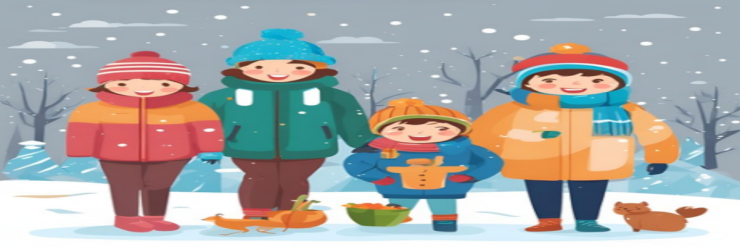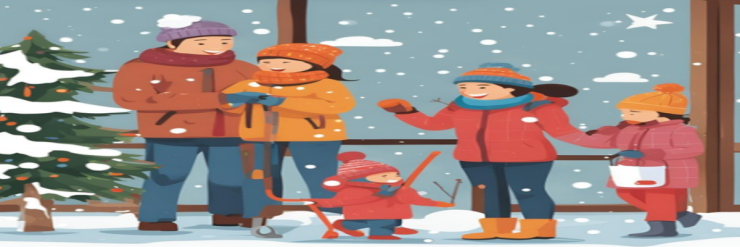Winter Illness Prevention: Stay Safe and Healthy
"Seasonal health means more than just preventing colds; it’s about thriving with energy and joy despite the chill." — LYF Mail

Winter Season Diseases and How to Stay Safe and Healthy
"Remember, health is built season by season—keep nurturing yourself even as the snow falls."
Winter brings with it a charm of cozy blankets, warm beverages, and holiday festivities, but it can also usher in a range of seasonal illnesses. With the drop in temperature, our bodies become more susceptible to various infections, making it essential to understand the risks and adopt preventive measures to stay safe and healthy. As temperatures drop and winter approaches, many people experience an uptick in seasonal illnesses. Cold weather can weaken our immune systems and create environments where certain viruses thrive. Understanding common winter ailments and taking preventive steps can help protect your health and well-being throughout the season. Here, we’ll look at common winter diseases, their symptoms, and effective strategies for keeping yourself and your loved ones protected.
Common Winter Season Diseases
1. Common Cold
The common cold, caused by various viruses, spreads easily in winter as people tend to spend more time indoors in close contact with others. Symptoms include a sore throat, runny or stuffy nose, cough, and sometimes a mild fever.
Cause: Various viruses, primarily rhinovirus.
Symptoms: Runny or stuffy nose, sore throat, coughing, sneezing, mild headache, and body aches.
Transmission: Airborne droplets from coughs or sneezes, close contact with infected individuals.
2. Flu (Influenza)
Flu is another viral illness that peaks in the winter months. Symptoms are more intense than the common cold and include high fever, body aches, extreme fatigue, and cough. In some cases, flu can lead to complications like pneumonia, especially in children and older adults.
Cause: Influenza virus.
Symptoms: Fever, chills, body aches, fatigue, sore throat, cough, and headaches.
Transmission: Spread through respiratory droplets and by touching contaminated surfaces.
3. Respiratory Syncytial Virus (RSV)
RSV is a respiratory virus that can cause severe infections, particularly in young children and the elderly. Symptoms are similar to those of the common cold but can escalate to bronchiolitis or pneumonia in severe cases.
Cause: Respiratory syncytial virus.
Symptoms: Cold-like symptoms, but can lead to bronchiolitis and pneumonia, especially in infants and the elderly.
Transmission: Spread via airborne droplets and contact with infected surfaces.
4. Pneumonia
Pneumonia can be viral, bacterial, or fungal, and it poses a serious threat, especially to vulnerable groups. Symptoms include chest pain, cough with phlegm, fever, and shortness of breath.
Cause: Bacterial, viral, or fungal infections.
Symptoms: Cough, fever, chills, shortness of breath, chest pain, fatigue, and muscle aches.
Transmission: Spread through direct contact, respiratory droplets, or exposure to certain environmental factors.
5. Strep Throat
Strep throat is a bacterial infection more prevalent in winter, causing a sore throat, fever, and swollen lymph nodes. It's highly contagious and requires antibiotics for treatment.
Cause: Group A Streptococcus bacteria.
Symptoms: Sore throat, pain while swallowing, red and swollen tonsils, fever, and headaches.
Transmission: Spread through respiratory droplets and contact with contaminated objects.
6. Seasonal Affective Disorder (SAD)
Cause: A type of depression associated with reduced sunlight exposure.
Symptoms: Fatigue, low mood, sleep disturbances, and lack of motivation.
Transmission: Non-infectious but affected by seasonal changes and lack of sunlight exposure.
7. Norovirus
Known as the "winter vomiting bug," norovirus causes gastroenteritis. Symptoms include vomiting, diarrhea, and stomach pain, and it spreads rapidly in crowded places.
Tips for Staying Safe and Healthy During Winter

1. Boost Your Immune System
a. Winter is the time to give your immune system extra support. Eat a diet rich in fruits, vegetables, and whole grains to get essential vitamins and minerals. Foods high in vitamins C and D, zinc, and antioxidants can enhance immune function.
b. Regular exercise also boosts immunity by promoting circulation and reducing stress, making it easier for your body to fight infections.
c. Eat a balanced diet rich in vitamins and minerals, particularly vitamin C, vitamin D, and zinc, which support immunity.
d. Stay hydrated, even in colder months, to keep your body functioning well.
2. Get Vaccinated
Vaccines remain one of the most effective ways to prevent flu and other infections like pneumonia. The flu vaccine is updated yearly to cover the most common strains, so getting vaccinated can significantly reduce your chances of contracting the virus.
a. The flu vaccine is highly recommended, especially for vulnerable groups such as young children, the elderly, and individuals with chronic conditions.
b. Consider getting the pneumonia vaccine if you are at a higher risk.
3. Practice Good Hygiene
Frequent handwashing with soap and water is one of the simplest and most effective ways to prevent the spread of germs. Make it a habit to wash your hands after being in public places, before meals, and after sneezing or coughing.
a. Avoid touching your face, as germs often enter through the eyes, nose, and mouth.
b. Wash your hands frequently with soap and water for at least 20 seconds.
c. Use hand sanitizers if soap and water are unavailable.
d. Avoid touching your face, especially your nose, mouth, and eyes, as these are common entry points for viruses.
4. Stay Active
a. Engage in regular exercise to improve circulation, maintain a healthy weight, and boost your immune response.
b. Try indoor exercises or a brisk outdoor walk to stay active, even if it’s cold.
5. Maintain a Warm Environment
a. Keep your living and workspaces warm, ideally between 18-21°C (64-70°F).
b. Use humidifiers to maintain moisture in the air, as dry winter air can worsen respiratory symptoms and dry out the skin.
6. Dress in Layers
a. Wear layered clothing to trap body heat and stay comfortable indoors and outdoors.
b. Don’t forget essential accessories like scarves, hats, and gloves to protect extremities from cold exposure.
7. Prioritize Sleep
a. Adequate sleep is crucial for immune function, so aim for 7-8 hours per night.
b. Establish a bedtime routine, reduce screen time before bed, and create a comfortable sleep environment.
8. Take Care of Your Mental Health
a. If you experience seasonal affective disorder symptoms, try to spend time outside during daylight hours.
b. Light therapy, yoga, meditation, and maintaining social connections can also help improve mood and mental well-being.
9. Avoid Crowded Places When Possible
a. Crowded indoor spaces can increase the risk of infection spread.
b. When visiting crowded areas, consider wearing a mask, particularly if you are in a high-risk group.
10. Monitor Your Health
a. Pay attention to early signs of illness like fatigue, headaches, or mild fever, and take preventive measures immediately.
b. Seek medical advice if symptoms worsen or if you have a persistent cough, difficulty breathing, or a high fever.
11. Stay Hydrated
It can be easy to overlook hydration in colder months, but drinking enough water is crucial for maintaining a healthy immune system. Hydration helps your body process nutrients more effectively and keeps mucous membranes moist, which can help trap germs before they enter your body.
When to Seek Medical Help

Knowing when to consult a doctor is key to staying safe during winter. If symptoms of a cold or flu worsen, you have a persistent high fever, shortness of breath, or chest pain, it’s important to see a healthcare provider. This is particularly true for those at higher risk, including the elderly, young children, and people with chronic health conditions.
Winter diseases are common but preventable with the right approach. A proactive and consistent focus on hygiene, nutrition, and lifestyle can help you navigate the winter months healthily. By taking preventive steps and staying aware, you can enjoy the winter season with minimal disruptions to your health and well-being.
1. The Common Cold and Public Health Impact
Example: Every year, millions of people worldwide experience the common cold, leading to significant work and school absences. In the United States alone, the CDC reports that adults get about two to three colds per year on average, while children may have even more. The common cold isn’t severe, but its frequency makes it a major cause of productivity loss and health burden, especially in crowded, cold-weather environments.
Preventive Actions in Practice: Many companies have implemented flexible work-from-home policies during cold and flu season to prevent the spread of viruses.
2. Flu Outbreaks and Vaccination Campaigns
Example: In 2017-2018, a severe flu season hit the United States, leading to an estimated 61,000 deaths and 810,000 hospitalizations. The World Health Organization (WHO) often reports high influenza activity during winter in both hemispheres, emphasizing the need for yearly flu vaccines.
Preventive Actions in Practice: Public health campaigns have promoted flu vaccinations worldwide. For instance, Australia encourages flu shots at the beginning of its winter season in May, offering free vaccines to children and the elderly through government programs.
3. RSV in Young Children and Elderly Populations
Example: Respiratory Syncytial Virus (RSV) causes severe respiratory illness, particularly among infants and the elderly. In 2022, hospitals in the United States faced an unprecedented surge in RSV cases, leading to near-capacity pediatric hospital wards. Similarly, Europe saw increased RSV cases, impacting vulnerable populations.
Preventive Actions in Practice: Many hospitals and clinics established hygiene stations, strict handwashing protocols, and limited visitor policies to reduce transmission in healthcare settings.
4. Pneumonia and Global Health Risks
Example: Pneumonia is one of the leading causes of death among children under five worldwide. In 2019, pneumonia accounted for about 15% of all deaths in this age group, with Sub-Saharan Africa and South Asia bearing the highest burden. In winter, colder climates and indoor confinement increase the risk.
Preventive Actions in Practice: Global initiatives such as the "Every Breath Counts" coalition have advocated for increased access to vaccines and treatments, particularly in low-income regions. Health campaigns encourage timely vaccinations against pneumococcal bacteria and influenza to reduce pneumonia risks.
5. Strep Throat in Schools and Daycare Centers
Example: Strep throat spreads rapidly in closed environments like schools and daycares, particularly during winter. In recent years, outbreaks have been recorded across schools in the U.K. and the U.S., leading to class absences and even school closures to prevent further spread.
Preventive Actions in Practice: Schools have implemented regular sanitation routines and encouraged hand hygiene among students. In the U.K., some schools provide regular health screenings to detect and treat strep throat early.
6. Seasonal Affective Disorder (SAD) in Northern Climates
Example: Seasonal Affective Disorder is common in regions with prolonged winter darkness, like Scandinavia and northern Canada. In Norway, for instance, long winters with minimal sunlight contribute to higher rates of SAD, impacting mental health and productivity.
Preventive Actions in Practice: Light therapy clinics are available in countries like Finland and Norway to help residents cope with the effects of reduced sunlight. Sweden also promotes outdoor physical activities to boost mood and combat SAD symptoms during winter.
Real-World Preventive Strategies for Winter Illnesses
Across the world, various strategies have been adopted by communities and governments to help manage and prevent the spread of winter illnesses:
Public Awareness Campaigns: Health organizations globally launch seasonal campaigns to promote vaccination, proper hand hygiene, and respiratory etiquette.
Hygiene Initiatives in Public Spaces: During winter months, many places like shopping centers, public transportation hubs, and schools increase cleaning frequency and place hand sanitizing stations in visible areas.
Workplace Adjustments: Companies in colder climates encourage remote work during winter months or sick leave flexibility to prevent contagious diseases like flu and RSV from spreading within offices.
Home Humidifiers and Heaters: In Japan and South Korea, where winter air can be quite dry, many households use humidifiers to keep respiratory systems moist, reducing susceptibility to cold and flu viruses.
These examples demonstrate the wide-ranging impact of winter diseases and how different regions and organizations are implementing real-world measures to mitigate these seasonal health risks. Adopting similar practices can help reduce the likelihood of illness and promote community health during the winter season.
Scientific References and Studies
1. Influenza (Flu) Prevention
Reference:
Grohskopf, L. A., Sokolow, L. Z., Broder, K. R., Olsen, S. J., Karron, R. A., & Walter, E. B. (2022). Prevention and Control of Seasonal Influenza with Vaccines: Recommendations of the Advisory Committee on Immunization Practices—United States, 2022-23 Influenza Season. *Morbidity and Mortality Weekly Report (MMWR)*, 71(1), 1–20.
Summary:
This annual report by the CDC provides recommendations for the use of influenza vaccines in the U.S. The study highlights the efficacy of annual flu vaccines in reducing severe illness and the spread of influenza.
Reference:
Pebody, R., Sinnathamby, M., Warburton, F., Andrews, N., et al. (2020). Uptake and effectiveness of the influenza vaccine in preventing hospital admissions in older adults in England: a test-negative case-control study. *Vaccine*, 38(29), 4637-4646.
Summary:
This study in the U.K. assesses the effectiveness of flu vaccines in reducing hospital admissions among older adults, emphasizing the importance of annual vaccination in vulnerable populations.
2. Common Cold and Hygiene Practices
Reference:
Jefferson, T., Foxlee, R., Del Mar, C., Dooley, L., Ferroni, E., Al-Ansary, L., & Bawazeer, G. (2007). Physical interventions to interrupt or reduce the spread of respiratory viruses: systematic review. *BMJ*, 336(7635), 77-80.
Summary:
This systematic review highlights that physical interventions like hand washing, wearing masks, and surface disinfection are effective in reducing the transmission of respiratory viruses, including those causing the common cold.
Reference:
Aiello, A. E., Coulborn, R. M., Perez, V., & Larson, E. L. (2008). Effect of hand hygiene on infectious disease risk in the community setting: a meta-analysis. *American Journal of Public Health*, 98(8), 1372-1381.
Summary:
The meta-analysis demonstrates that proper hand hygiene can significantly reduce the risk of contracting respiratory infections in community settings, reinforcing the importance of hand washing during winter.
3. RSV Prevention in High-Risk Populations
Reference:
Feltes, T. F., Cabalka, A. K., Meissner, H. C., Piazza, F. M., Carlin, D. A., Top, F. H., & Connor, E. M. (2003). Palivizumab Prophylaxis Reduces Hospitalization Due to Respiratory Syncytial Virus Infection in High-Risk Infants. *Pediatrics*, 112(2), 283-290.
Summary:
This study investigates the use of palivizumab, a monoclonal antibody, in reducing RSV hospitalizations among high-risk infants, supporting its use as a preventive measure during RSV season.
Reference:
Hall, C. B., Weinberg, G. A., Blumkin, A. K., et al. (2013). Respiratory syncytial virus-associated hospitalizations among children less than 24 months of age. *Pediatrics*, 132(2), e341-e348.
Summary:
This study explores RSV infection rates and hospitalizations, emphasizing the importance of preventive measures, especially among children under two, including hand hygiene and minimizing exposure in crowded places.
4. Pneumonia and Vaccination
Reference:
Bonten, M. J. M., Huijts, S. M., Bolkenbaas, M., Webber, C., Patterson, S., Gault, S., & Grobbee, D. E. (2015). Polysaccharide Conjugate Vaccine against Pneumococcal Pneumonia in Adults. *New England Journal of Medicine*, 372(12), 1114-1125.
Summary:
This randomized trial demonstrates the effectiveness of the pneumococcal conjugate vaccine in preventing pneumonia among adults, especially in older populations, during high-risk winter months.
Reference:
Simonsen, L., Taylor, R. J., Young-Xu, Y., Haber, M., May, L., & Klugman, K. P. (2011). Impact of pneumococcal conjugate vaccination of infants on pneumonia and influenza hospitalization and mortality among all age groups in the United States. *Clinical Infectious Diseases*, 52(7), 949-957.
Summary:
The study shows that pneumococcal vaccines for infants indirectly reduce pneumonia and influenza-related hospitalizations across all age groups, illustrating the broad public health impact of vaccination.
5. Strep Throat and School-based Hygiene Measures
Reference:
Carapetis, J. R., Steer, A. C., Mulholland, E. K., & Weber, M. (2005). The global burden of group A streptococcal diseases. *The Lancet Infectious Diseases*, 5(11), 685-694.
Summary:
This review explores the burden of group A streptococcus worldwide, including the prevalence of strep throat in school-aged children, and highlights hygiene measures and prompt treatment to prevent outbreaks in community settings.
6. Seasonal Affective Disorder (SAD) and Light Therapy
Reference:
Lam, R. W., Levitt, A. J., Levitan, R. D., Enns, M. W., Morehouse, R., Michalak, E. E., & Tam, E. M. (2006). The CAN-SAD study: a randomized controlled trial of the effectiveness of light therapy and fluoxetine in patients with seasonal affective disorder. *American Journal of Psychiatry*, 163(5), 805-812.
Summary:
This study assesses the effectiveness of light therapy for individuals with Seasonal Affective Disorder (SAD), finding significant improvements in mood, underscoring light therapy as an effective preventive measure in winter.
Reference:
Golden, R. N., Gaynes, B. N., Ekstrom, R. D., Hamer, R. M., Jacobsen, F. M., Suppes, T., & Nemeroff, C. B. (2005). The efficacy of light therapy in the treatment of mood disorders: a review and meta-analysis of the evidence. *American Journal of Psychiatry*, 162(4), 656-662.
Summary:
This meta-analysis reviews the efficacy of light therapy for mood disorders, including SAD, supporting its use as a preventive measure to mitigate symptoms caused by lack of sunlight in winter months.
These references support the importance of preventive measures such as vaccination, hygiene, light therapy, and environmental controls in mitigating the impact of winter diseases worldwide.
